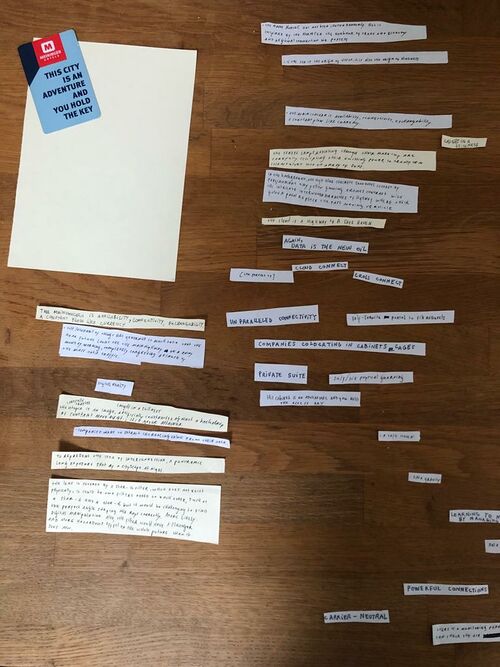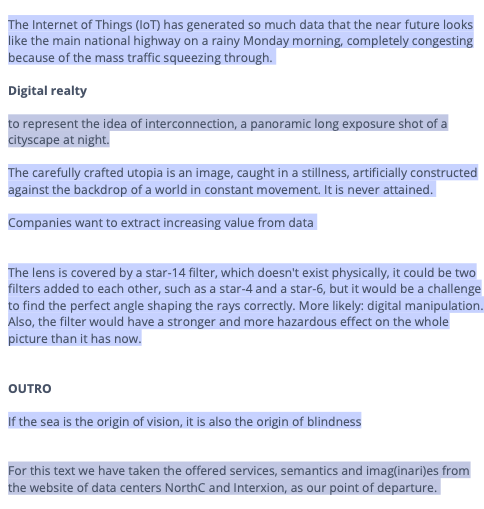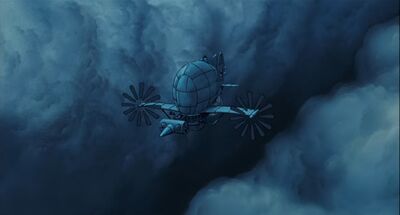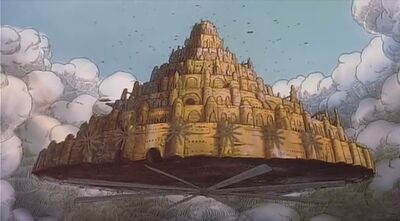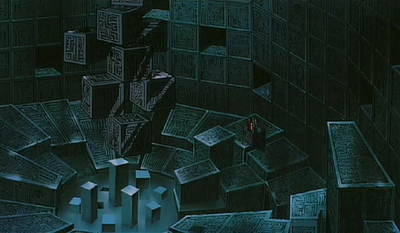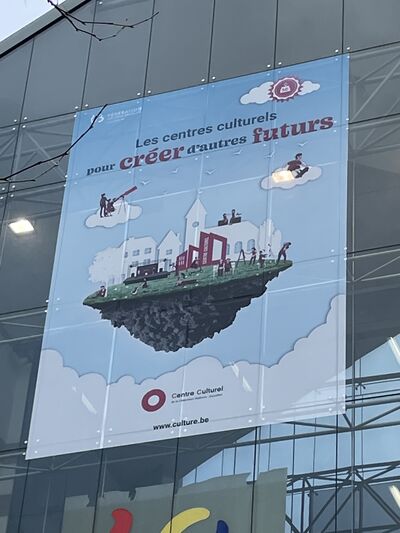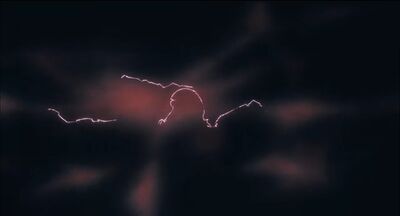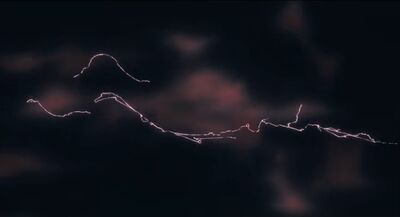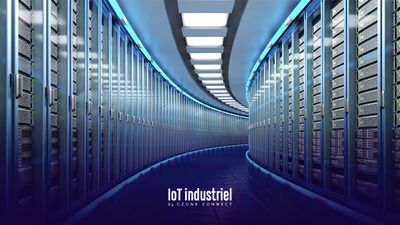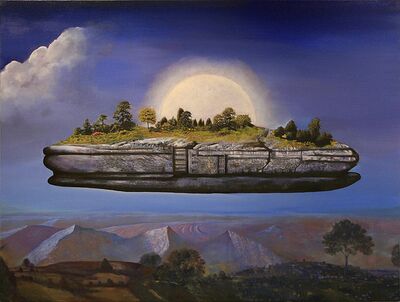User:Trashpuppy/Mapping
FIRST WEEK
This weeks PAD: https://pad.xpub.nl/p/The_dark_cloud__a_centre_for_data
Writing 1: Interconnection: the 13th Moon
Collective speculative writing exercise for which we have taken the offered services, semantics and imag(inari)es from the website of data centers NorthCand Interxion, as our point of departure. From this we have constructed a skeleton that we are both going to elaborate and refine separately but bringing them back in parallel connection! Diverting but never divorcing.
The method is inspired by reading "The twelth Moon" in Sepculative Facts, it's a collaborative story written on whatsapp by Sepake Angiama, Clare Butcher, Byron Kalomamas. The story speculating on the conservative election win in the UK at the end of 2019.
File:12thMoon reading.pdf
References
The Big Hack (2019) - Karim Amer, Jehane Noujaim
Birgitte Kaiser: last year data surpassed oil in value.
Alice Sparkly Kitten: data has no value. Data is capital, that against which the value of things is measured. ... Data is dept
Castle in the sky - Studio Gibli
The cloud is a physical infrastructure, a city. Often depicted indeed, suspended in mid air.
Laputa, the highly technologically advanced city of the sky, as a metaphor for the cloud
Attack of the pirates, a metaphor for the hacking the cloud.
entering the dark cloud
In Free Fall: A Thought Experiment on Vertical Perspective - Hito Steyerl [1]
Self-hosted servers
Counter-point to the inaccessible pandora's black boxes of data centers.
Agiles - The history of the cloud: a journey through the last 60 years [2]
First cloud was amazon cloud, not apple.
"The development of microchips made computing considerably "cheaper" and smaller."
Moore's law (1965) , the observation that the number of transistors in a dense integrated circuit (IC) doubles about every two years. Moore's law is an observation and projection of a historical trend. Rather than a law of physics, it is an empirical relationship linked to gains from experience in production.[3]
the amount of circuits would double in regards to the size of a chip.
Really related to the weight of the files you want to transcode, process. Rules the laws of the industry
Interesting how this is talked about in the industry as a law of physics, while its a predication a trend
a business model: we have to live up to this prediction. It's a given, a goal. While you can question it.
so of course they are going to reach this goal. It's a self-fulfilling prophecy. Adele: 'thats the definition of progress in a way.' What do you define as progress? What do you want as progress?
What is a
transistor?
The evolution of the number of transistors, the amount of data you can process of store on a chip, over the years. The curve is so exponential. Right now we are arriving at this moment where we dont know where its going, but its not that exponential. Probably things are going to cost more. We are at a point where its stabilising. But maybe thats why its gonna become expensive. A shortage of ships and resources. We are now going to have to rely on the materiality of the hardware and efficiency of software. We're running out of resources.
>>>>>Workshop Automation of care V2: T
People are convinced we are not going to run out of resources because of colonising the ocean and space.
"Hardly any other achievement represents the rapid progress of the technologies underlying the cloud like the World Wide Web."
compaq
https://s3.amazonaws.com/files.technologyreview.com/p/pub/legacy/compaq_cst_1996_0.pdf There already is a visualisation of the cloud!
Birth of the modern cloud
"The modern cloud was born in 2002 when Amazon founded a cloud computing platform to ensure the security and stability of its website. The possibility to rent unused storage and computing capacity was a side benefit. https://aws.amazon.com/what-is-aws/ --> Digital realty: renting outage unused storage space sounds like the housing industry. Kendal: squatting abandoned websites. The website and server, infrastructure is still there but what is happening there? Opening up the potential for reappropriating.
In 2005, OpenNebula was initiated. https://opennebula.io/
With the foundation of Dropbox in 2007, the concept of storing files in the cloud emerged. New data centers popped up everywhere.
"Given the possibility to monitor the resources, the trust in the cloud grew."
"Containers are the most common virtualization technique in the microservice architecture." https://docs.microsoft.com/de-de/dotnet/architecture/containerized-lifecycle/docker-application-lifecycle/containers-foundation-for-devops-collaboration
data gravity, edge computing and fog computing (https://dl.acm.org/doi/pdf/10.1145/2342509.2342513)
tensor processed unit (tpu): custom-designed machine learning https://cloud.google.com/tpu "Moreover, the hardware in the data centers is becoming more heterogeneous. This is because graphic processors complement the traditionally used processors (i.e. CPUs) to speed up the execution of applications running on the cloud."
"In 2018, Microsoft started testing the world’s first subsea data center." https://natick.research.microsoft.com/
"The history of the cloud is a success story"
Moreover, IT experts from the provider take care of software updates and of the operation and maintenance of the data centers.
The golden age of the cloud has only just begun.
Transition from industrial revolution cloud (domination of nature) now to the organic cloud (working with nature). Greenwashing. The next nature - virtual reality as part of nature. We are going to erase the consequences of these consequences.
Martin: On the one hand cosntrast: industrial and organic The irony that we envision data centers are in the sky. Something thats above us, data centers are on the ground. Interesting that we see it, even before it has gone up, as something divine and heavenly, even before it has gone up. Adele: I wonder what the role fo satellites is in this. Maybe it has something to do with relaying. I wonder how this works.
Does it really travel through air and space?
Cloud and heaven, a gateway
Bad gateway: heaven

